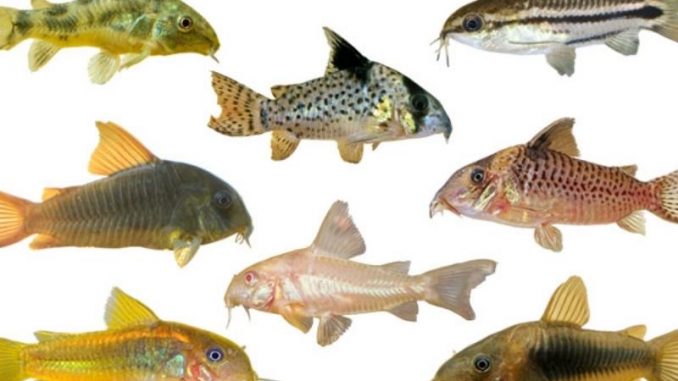
The cory catfish is a freshwater fish that is native to the Atlantic coastline of South America and is commonly found in areas stretching from Trinidad to northern Argentina.
Home aquarists enjoy keeping cory catfish because they are easy to care for, are compatible with most other peaceful, tropical fish of similar size, and because they are bottom-feeders, they help keep the tank clean. Most types of cory catfish are readily available in pet stores.
There are many types of cory catfish and this article will cover the most popular species that are suited to small tanks.
TABLE OF CONTENTS
Bronze Cory
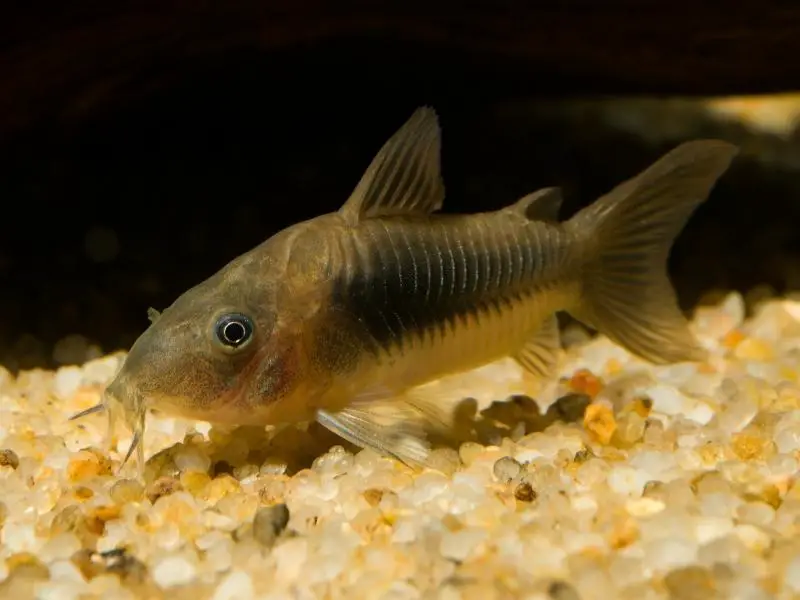
| Care level: | Temperament: | Color: | Lifespan: | Size: |
| Easy | Peaceful | Green or black | 5 years | 2.5 inches |
| Water temperature: | Water pH: | Tank size: | Diet: | Scientific name: |
| 72–79°F | 5.8–7 | 10 Gallons | Omnivore | Corydoras aeneus |
The bronze cory catfish is popular among aquarists because it is easy to care for. A fully-grown bronze cory is 2.5 inches long and can thrive in a 10-gallon tank.
Bronze cories like soft water with a dGH of 2–30. They spend most of their time swimming around the bottom of the tank and enjoy peacefully mixing with other small tropical fish.
As their name suggests, bronze cories have shimmery bodies with a bronze sheen and come in many shades of green and black.
Albino Cory
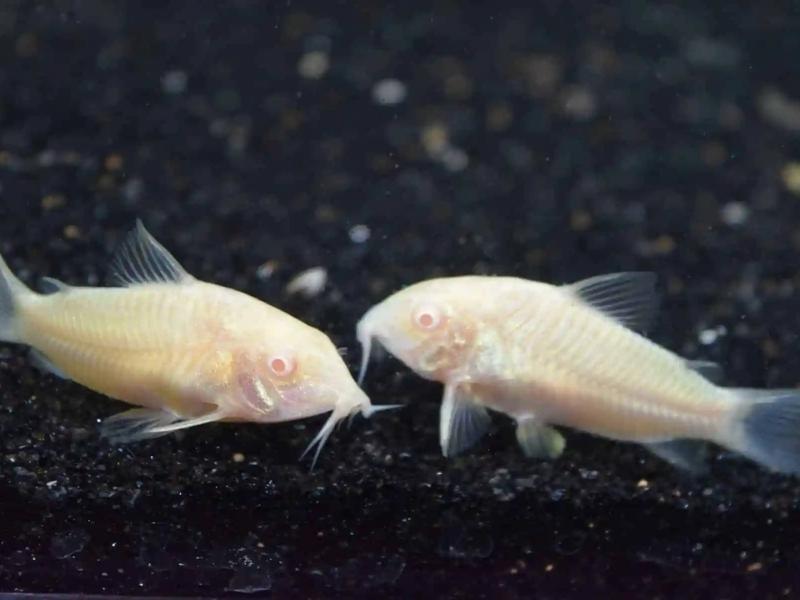
| Care level: | Temperament: | Color: | Lifespan: | Size: |
| Easy | Peaceful | Pinkish white | 5 years | 2 inches |
| Water temperature: | Water pH: | Tank size: | Diet: | Scientific name: |
| 72–79°F | 5.8–7 | 10 Gallons | Omnivore | Corydoras paleatus |
The albino cory is a popular catfish that was bred for its unique red eyes and lack of skin pigment, resulting in a white to pinkish appearance.
Albino cory catfish are a peaceful species that get along well with other cory and small tropical fish.
Because of its lack of protective skin pigment, the albino cory’s tank should be sheltered from bright light and decorated with plenty of vegetation where it can hide.
Three Stripe Cory
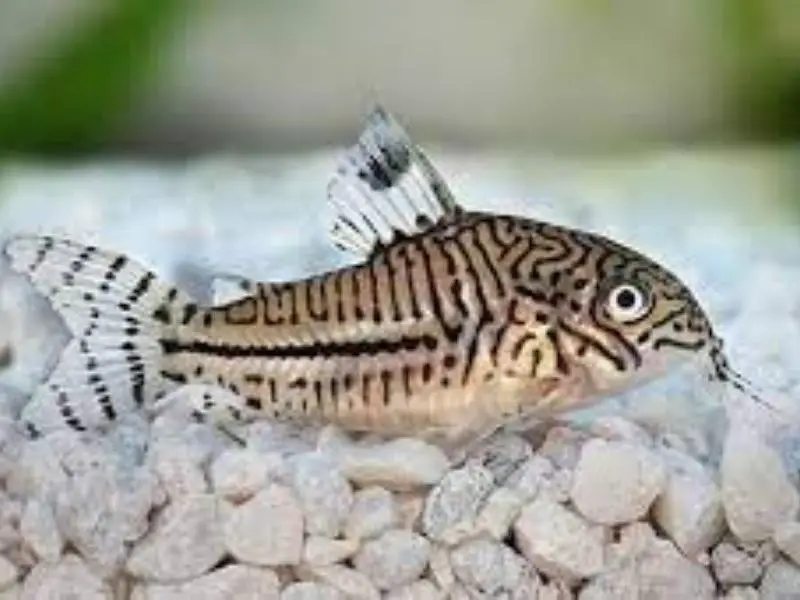
| Care level: | Temperament: | Color: | Lifespan: | Size: |
| Easy | Peaceful | White with black and gray patterns | 5 years | 2 inches |
| Water temperature: | Water pH: | Tank size: | Diet: | Scientific name: |
| 68–78°F | 5.8–7 | 15 gallons | Omnivore | Corydoras trilineatus |
The three stripe cory is much loved for its distinctive, blackish spots and stripes over a white background.
Three stripe cories are hardy fish that are easy to care for. They like soft water and can tolerate a broad range of water temperatures.
Three stripe cories are sociable fish that enjoy a community tank setup. Their tank should be a minimum of 15 gallons and be populated by at least six fish.
Emerald Cory
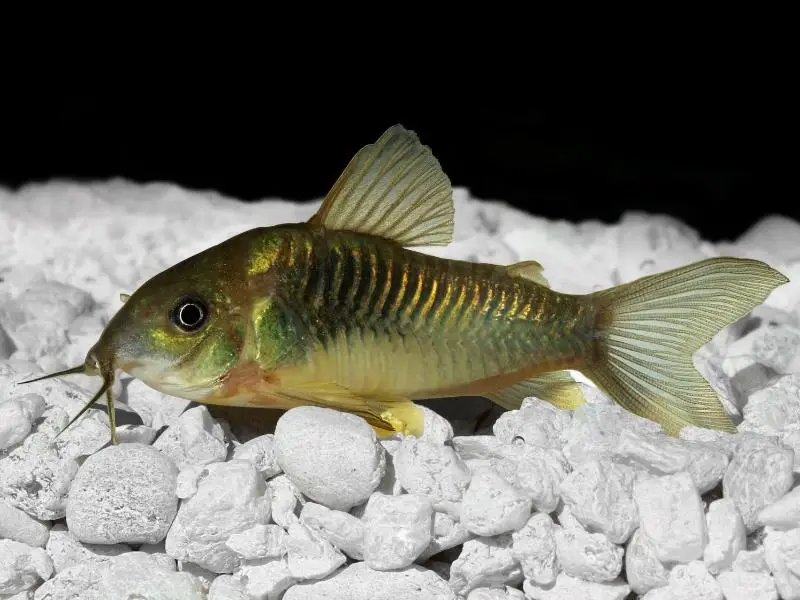
| Care level: | Temperament: | Color: | Lifespan: | Size: |
| Easy | Peaceful | Green | 5 years | 3.5 inches |
| Water temperature: | Water pH: | Tank size: | Diet: | Scientific name: |
| 72–79°F | 6–7 | 20 Gallons | Omnivore | Corydoras splendens |
The emerald cory is a popular catfish among home aquarists because of its strikingly-green color and pinkish tail.
The emerald cory is a peaceful, sociable catfish that enjoys being part of a large school of 10 or more fish. Other types of cory catfish make suitable tankmates.
The emerald cory is easy to care for and can tolerate a wide range of water conditions. Its tank should be at least 20 gallons to accommodate its tank mates.
This catfish likes bright light and enjoys having rocks and driftwood in its tank.
Panda Cory
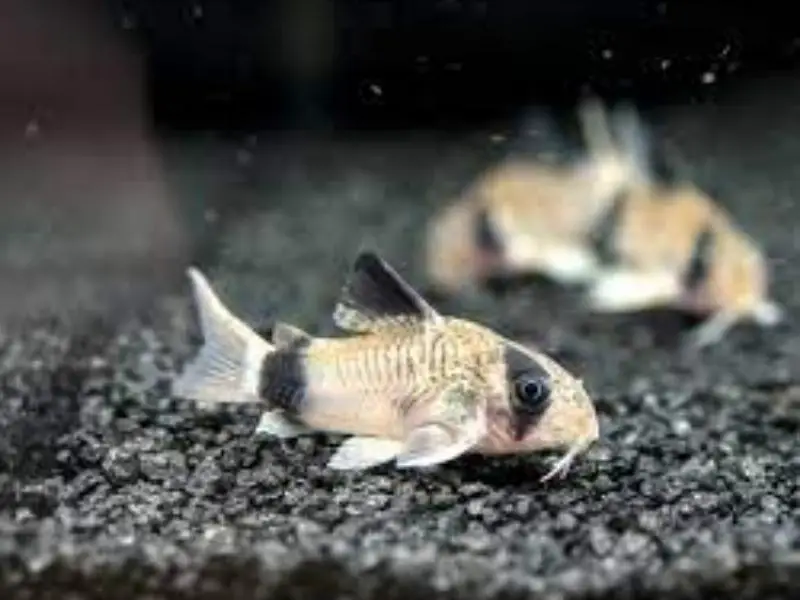
| Care level: | Temperament: | Color: | Lifespan: | Size: |
| Easy | Peaceful | Whitish-pink with black markings | 5 years | 2.5 inches |
| Water temperature: | Water pH: | Tank size: | Diet: | Scientific name: |
| 68–77°F | 6–7 | 10 Gallons | Omnivore | Corydoras panda |
The panda cory is named for its black markings over the eyes, similar to that of a panda bear. The panda cory is a sociable catfish that gets along well with other small fish and enjoys living in a community tank.
Panda cories enjoy cooler water than most freshwater tropical fish, as their natural habitats are fast-flowing rivers fed with snowmelt.
Panda cories stay close to the bottom of the tank where they scavenge for food. Feed with sinking pellets to ensure that the panda cory gets enough to eat.
Julii Cory
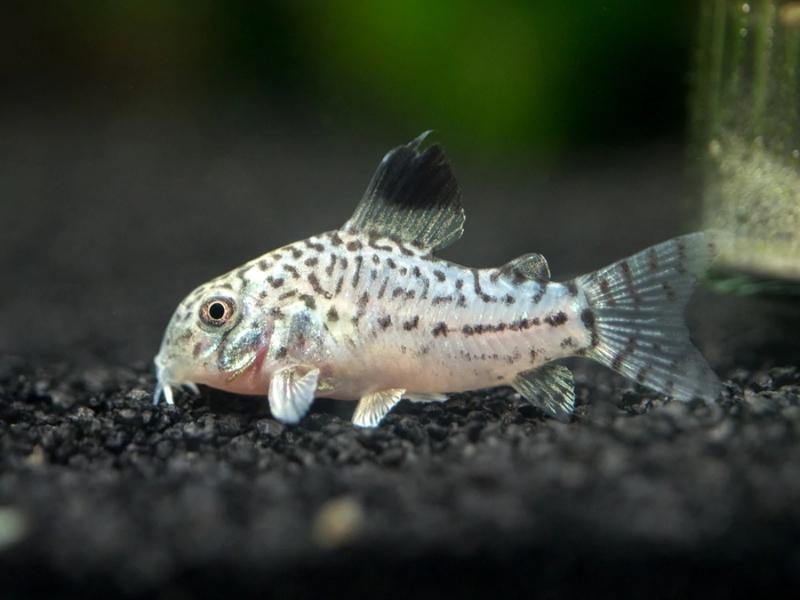
| Care level: | Temperament: | Color: | Lifespan: | Size: |
| Easy | Peaceful, nocturnal | Silver with black stripes | 5 years | 2.5 inches |
| Water temperature: | Water pH: | Tank size: | Diet: | Scientific name: |
| 72–79°F | 6.5–7.8 | 10 Gallons | Omnivore | Corydoras julii |
The julii cory is popular with aquarists because of its entertaining ability to rotate its eyes, making it look like it’s winking. Julii cory can be difficult to find in pet stores because they’re not fished commercially.
The julii cory is known as an armored catfish because it is covered with hard, overlapping plates called scutes in place of scales, and tiny spikes to protect them from predators.
Julii cories hover at the bottom of the tank where they use their barbels to pick up food. Provide a substrate of soft sand to prevent the julii cory from injury when scavenging for food.
Julii cories are nocturnal and like to eat at night.
Skunk Cory
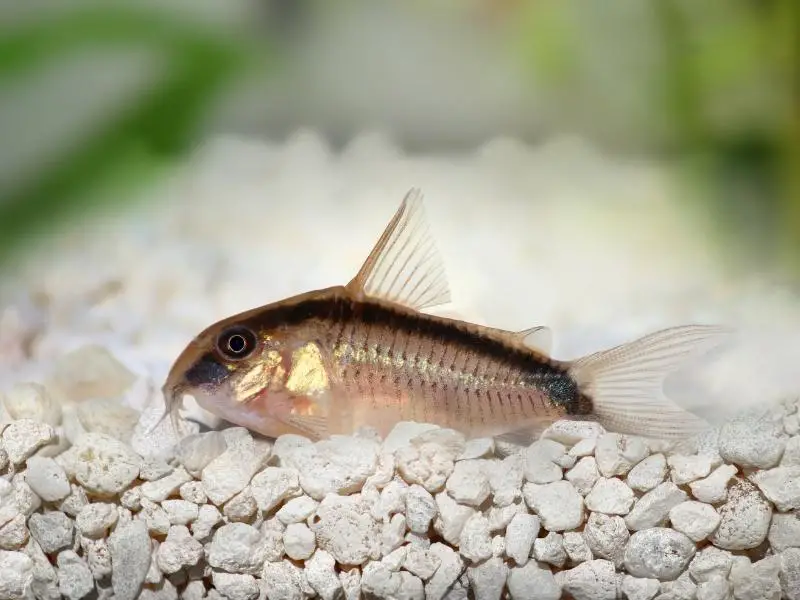
| Care level: | Temperament: | Color: | Lifespan: | Size: |
| Easy | Peaceful | Off-white with a black stripe down its back | 5 years | 2 inches |
| Water temperature: | Water pH: | Tank size: | Diet: | Scientific name: |
| 72–79°F | 6–7 | 15 Gallons | Omnivore | Corydoras arcuatus |
The skunk cory, also known as the arched cory, is a popular catfish known for the black stripe down its back that gives it a skunk-like appearance.
Many aquarists like the skunk cory’s unusual markings. Like most other cory species, skunk cories have scutes instead of scales as protection against predators.
Skunk cories are sociable and thrive in schools of six or more. Suitable tankmates are other cories, tetras, and danios. Skunk cories like swimming at the bottom of the tank and hiding in plants.
Bandit Cory
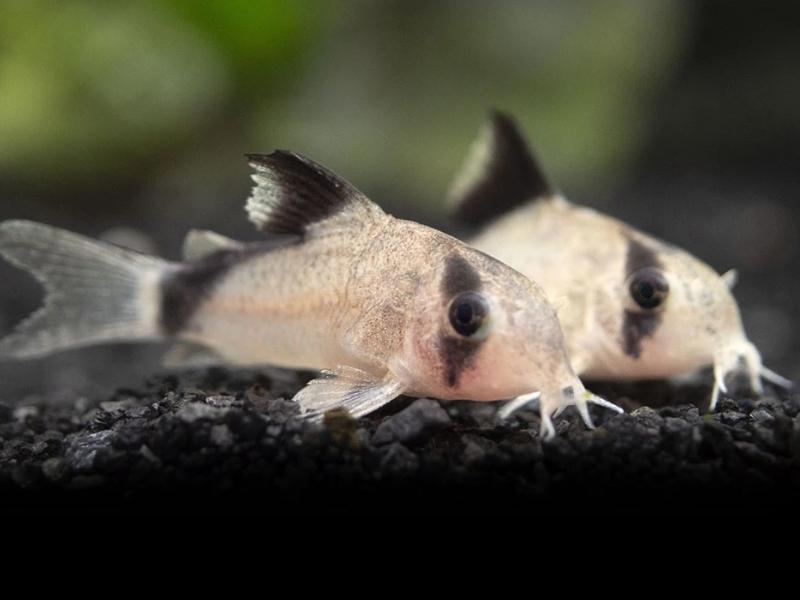
| Care level: | Temperament: | Color: | Lifespan: | Size: |
| Moderate | Peaceful | Silver and black | 5 years | 2 inches |
| Water temperature: | Water pH: | Tank size: | Diet: | Scientific name: |
| 72–79°F | 5.8–7 | 10 gallons | Omnivore | Corydoras metae |
The bandit cory is a peaceful catfish that gets its name from the black bandit-like patch covering its eyes. Bandit cories are silver in color and have smooth skin without scales.
The bandit cory prefers a dimly-lit community tank decorated with soft sand and plants that won’t damage its fine skin.
Monitor bandit cories closely and take care of any skin damages that can easily be incurred by their surroundings.
Pepper Cory
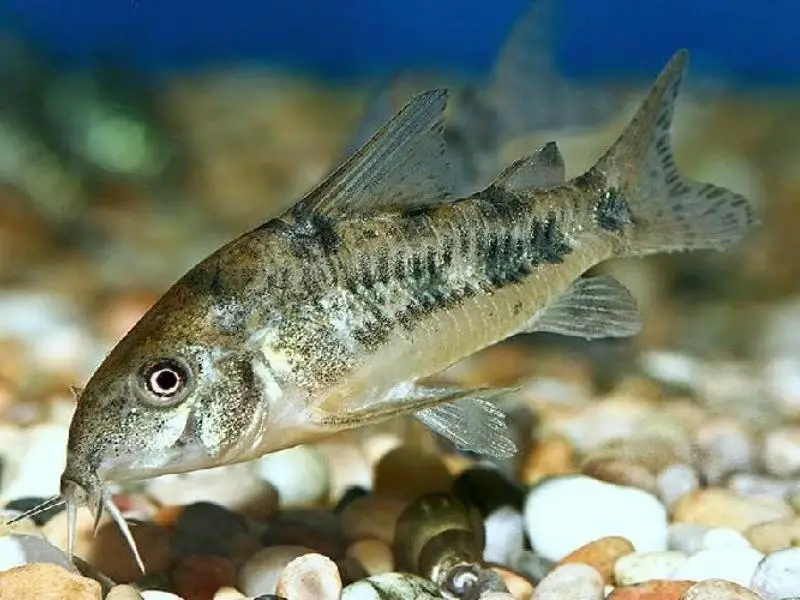
| Care level: | Temperament: | Color: | Lifespan: | Size: |
| Moderate | Peaceful | Light green with dark markings | 5 years | 2.5 inches |
| Water temperature: | Water pH: | Tank size: | Diet: | Scientific name: |
| 72–79°F | 6–7 | 15 Gallons | Omnivore | Corydoras paleatus |
The pepper cory is one of the most popular cory fish because it is friendly and gets along well with most other small fish. Like the julii, the pepper cory moves its eyes up and down in such a way that it looks like it is winking.
A pepper cory is light green with irregular-shaped dark green or black markings.
Pepper cories keep to the bottom of the tank, occasionally swimming to the top to raise their heads above the surface for oxygen.
The pepper cory is a sociable catfish that enjoys being part of a school of at least six fish. A minimum of a 15-gallon tank is necessary to accommodate the pepper cory and its school.
The pepper cory is sensitive to sudden fluctuations in water parameters. The pH level should remain at a steady 6–7 pH with a water hardness of 12 dGH.
Choosing & Caring for Different Types of Cory Catfish
Most types of cory catfish are easy to care for and are readily available in pet stores.
Cories are peaceful, sociable bottom-feeder catfish, and most species enjoy living in community tanks of at least six other fish of similar temperament and size.
Cory catfish eat sinkable food pellets and prefer 10- to 15-gallon-sized tanks decorated with a soft sand substrate.
Cory catfish are interesting to watch and have interesting colorings and markings. Choose those that you find the most appealing and attractive.

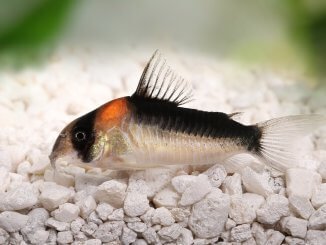
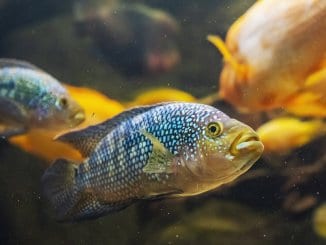
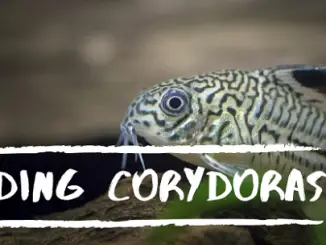
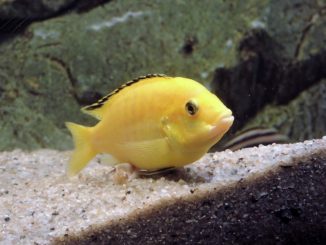
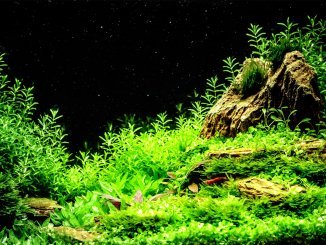
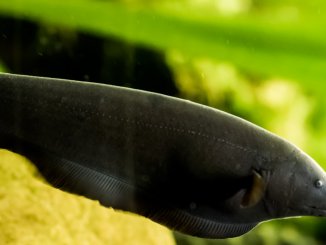
Be the first to comment